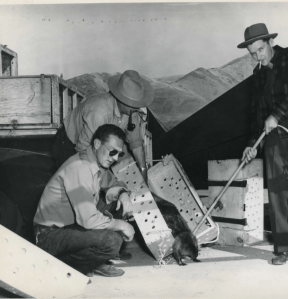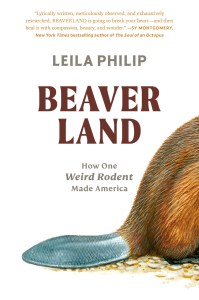Leila Philip’s Fast Facts About The World of Beavers
Beaverland reveals the natural wonder and unsung impact that beavers have had on American history and our landscape, and how they may be keystone species to restoring balance and biodiversity during the coming climate crisis. Read ahead for Leila Philip’s 7 fast facts about the world of beavers and their history creating America.
1.
The largest animal construction on Earth is a beaver dam.
Seen from space it spans over a 1/2 long – twice the length of the Hoover dam! We have no idea when or why the first beaver picked up the first stick and made the first dam, but they are the only animal that can build like this. And beaver-made construction endure. In Beaverland, I search for historic beaver sites in the Upper Peninsula of Michigan. And yes, I found some! One is well over 150 years old…and beavers still live there.
2.
Beavers the size of bears once roamed North America. (alongside mastodons and saber-toothed tigers).
Paleontologists unearthed the first skeleton in Ohio, thus their name, Castoroides Ohioensis. Some believe that the Great Beaver stories of the Algonquian peoples reflect paleo memories of these megafauna beavers that roamed the Pleistocene.
3.
Let’s just say it, beavers are (wonderfully) weird.
Beavers have two sets of orange teeth that never stop growing.
Beavers can topple a good-sized tree in ten minutes – spitting out wood chips like a furry chainsaw.
Beavers grind their teeth to relax.
Beavers never step backwards.
Beavers chuckle when they are happy.
When baby beaver stalk, and they talk constantly, their mewling sounds like a human infant.
4.
Beavers have lustrous fur which they groom with catlike fastidiousness.
A square of beaver fur the size of a postage stamp contains more hair than we have on our entire head – about 126,000 individual strands. When Europe went crazy for their fur in the 16th century, it helped lead to the exploration of North America.
5.
The return of beavers to North America is one of the greatest Conservation comeback stories of the 20th century.
The fur trade almost wiped beavers out from North America, but starting in 1904 in New York State’s Adirondack Park, wildlife re-introduction programs began releasing beavers back into the landscape. The most famous of these, (and maybe the zaniest) was the Idaho program in 1948 which dropped beavers into the Idaho wilderness by parachute. The first beaver they dropped was named “Geronimo”.
 Courtesy of Idaho Fish and Game
Courtesy of Idaho Fish and Game
6.
In Medieval Europe and throughout Asia, Beavers were hunted for their castor, which was a prized medicinal (and aphrodisiac).
The Roman naturalist, Pliny lauded the medicinal uses of beaver castor for everything from headaches to epilepsy, hysteria, and even insanity. Because beavers eat willow, which contains salicylic acid, beaver castor has traces of this ingredient which is a precursor to aspirin. Beavers were once abundant in Iran, Mongolia, China and throughout Europe.
7.
Beaver castor is used to flavor candy, ice cream, and high-end liqueurs.
If you have eat strawberry-flavored candy or ice cream you have probably eaten beaver castor because it enhances raspberry and strawberry flavors and is labeled as a natural “food additive” by the FDA. If you like whiskey, vodka or bourbon you can choose from several high-end beaver castor scented blends like Tamworth’s elite 88 proof Eau de Musc.
An intimate and revelatory dive into the world of the beaver—the wonderfully weird rodent that has surprisingly shaped American history and may save its ecological future.
From award-winning writer Leila Philip, BEAVERLAND is a masterful work of narrative science writing, a book that highlights, though history and contemporary storytelling, how this weird rodent plays an oversized role in American history and its future. She follows fur trappers who lead her through waist high water, fur traders and fur auctioneers, as well as wildlife managers, PETA activists, Native American environmental vigilantes, scientists, engineers, and the colorful group of activists known as beaver believers.
What emerges is a poignant personal narrative, a startling portrait of the secretive world of the contemporary fur trade, and an engrossing ecological and historical investigation of these heroic animals who, once trapped to the point of extinction, have returned to the landscape as one of the greatest conservation stories of the 20th century. Beautifully written and impeccably researched, BEAVERLAND reveals the profound ways in which one odd creature and the trade surrounding it has shaped history, culture, and our environment.
Discover More Fast Facts From Our Authors


